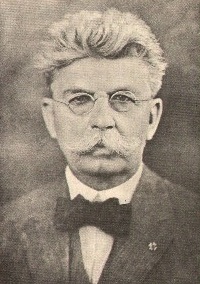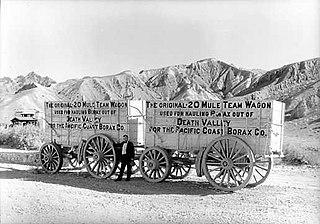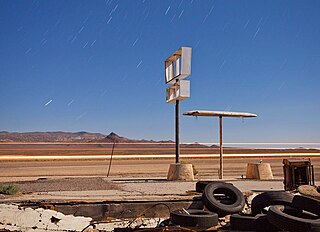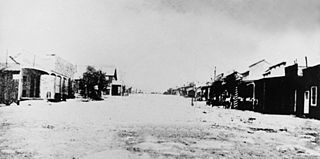This article has multiple issues. Please help to improve it or discuss these issues on the talk page . (Learn how and when to remove these template messages)
|
Marietta, Nevada, was a town in Mineral County, Nevada. It is now a ghost town.
This article has multiple issues. Please help to improve it or discuss these issues on the talk page . (Learn how and when to remove these template messages)
|
Marietta, Nevada, was a town in Mineral County, Nevada. It is now a ghost town.
The area was extensively prospected by the well-known prospector F.M. "Borax" Smith, and Teel's Marsh near Marietta is often credited with providing Smith his start in the borax business (having earlier been a more common silver and gold prospector). [1] However, before Smith came to the area it had been periodically mined for salt, which was used in the processing of ore in the Virginia City, Aurora, NV, and Bodie, CA mills. The use of camels to transport salt to Virginia City has often been quoted, although there is some dispute whether this actually took place. Mule teams were the more usual method of transporting the salt. F.M. Smith began serious scraping and processing of the borax and salt deposits starting in 1872, mainly from deposits on nearby Teels Marsh.
Marietta was formally established as a town in 1877, and soon contained several hundred people. Exact figures are hard to verify, because many of the workers involved in the scraping process, and at the processing plant on Teels Marsh were Chinese, whose population figures were not accurately kept. The town soon boasted 13 saloons, a post office, several stores (including the one owned and operated by 'Borax' Smith), and many stone and adobe structures. Marietta was a rowdy camp, despite its size, and seemed to garner more than its fair share of criminal activity. The stage service working to and from Marietta was reportedly robbed 30 times in 1880, within one week of that year alone it was robbed 4 times. The town's isolated site made it an easy target for robberies, and for criminals to run freely.
Despite the crime, scraping the marsh and processing the borax and salt was very lucrative, as was some small amount of gold and silver mining nearby. For the better part of 20 years Marietta soldiered on. However, starting in the early to mid 1890s, the markets for borax and salt had expanded from the central and western area of Nevada to the growing markets in southern California. F.M. Smith had found much larger and more extensive borax deposits in the Death Valley, California area, and once he had established his works there, he closed down his operations in Marietta. With this source of income gone, the town quickly faded, and was largely abandoned by the early 1900s. In the 1930s some work in the nearby ranges in silver and gold operations saw a brief resurgence in the town, but this did not last long, and Marietta again slipped into obscurity. There was yet another spate of activity in the 1950s and 60's, with the location of small amounts of uranium ore in the area, but it was never found in large quantities, and large scale activity was never undertaken.
In the past 20 years there has been sporadic mineral exploration in the area. The newer industrial buildings in Marietta are mostly from this activity. A few people live in the area as caretakers. One recent exploration company is The Great Western Mining Corporation, an Irish based exploration company, which concentrates on gold, silver and uranium exploration in the Little Huntoon Valley area near Marietta. Visitors to the site of Marietta should take care not to enter or trespass on any of these private properties while exploring the ruins of the town.
Since 1991 the area is a federally (BLM) managed Wild Burro Range. This 68,000-acre (280 km2) range, which includes the site of Marietta and Teels Marsh, is home to about 85 burros. Small groups of the burros can often be found roaming among the ruins of Marietta.
Marietta is at 38°14′36″N118°20′19″W / 38.24333°N 118.33861°W , at an elevation of 4947 feet (1508m).

Death Valley National Park is an American national park that straddles the California–Nevada border, east of the Sierra Nevada. The park boundaries include Death Valley, the northern section of Panamint Valley, the southern section of Eureka Valley and most of Saline Valley. The park occupies an interface zone between the arid Great Basin and Mojave deserts, protecting the northwest corner of the Mojave Desert and its diverse environment of salt-flats, sand dunes, badlands, valleys, canyons and mountains. Death Valley is the largest national park in the contiguous United States, as well as the hottest, driest and lowest of all the national parks in the United States. It contains Badwater Basin, the second-lowest point in the Western Hemisphere at 282 feet (86 m) below sea level. More than 93% of the park is a designated wilderness area. The park is home to many species of plants and animals that have adapted to this harsh desert environment including creosote bush, Joshua tree, bighorn sheep, coyote, and the Death Valley pupfish, a survivor from much wetter times. UNESCO included Death Valley as the principal feature of its Mojave and Colorado Deserts Biosphere Reserve in 1984.

Prospecting is the first stage of the geological analysis of a territory. It is the search for minerals, fossils, precious metals, or mineral specimens. It is also known as fossicking.

Charles Augustus Steen was a geologist who made and lost a fortune after discovering a rich uranium deposit in Utah during the uranium boom of the early 1950s.

Francis Marion Smith was an American miner, business magnate and civic builder in the Mojave Desert, the San Francisco Bay Area, and Oakland, California.

The Pacific Coast Borax Company (PCB) was a United States mining company founded in 1890 by the American borax magnate Francis "Borax" Smith, the "Borax King".

Gold Point, Nevada is a well-preserved historic mining town in Esmeralda County, Nevada. The community was named after the local gold-mining industry. Gold Point is the southern terminus of Nevada State Route 774. Its current population is about seven.

Coaldale is a former mining town and true ghost town in Esmeralda County, Nevada, located at the junction of U.S. Route 6 and U.S. Route 95 about 40 miles (64 km) west of Tonopah.

Columbus was a borax mining boom town in Esmeralda County. Its remnants are located on the edge of the Columbus Salt Marsh.
Franc Renault Joubin, was an American prospector and geologist best known for a huge uranium discovery in northeastern Ontario, Canada in 1953.

Uranium mining in Colorado, United States, goes back to 1872, when pitchblende ore was taken from gold mines near Central City, Colorado. The Colorado uranium industry has seen booms and busts, but continues to this day. Not counting byproduct uranium from phosphate, Colorado is considered to have the third largest uranium reserves of any US state, behind Wyoming and New Mexico.

Wonder, Nevada, is a ghost town in Churchill County, Nevada, approximately 39 miles (63 km) east of Fallon.

Rawhide, Nevada was a town in Mineral County, Nevada, approximately 55 miles southeast of Fallon. The site of Rawhide has been dismantled by recent mining activity, with little or nothing remaining to be seen.

Candelaria is a ghost town in Mineral County, Nevada. Today the site of Candelaria is dominated by the Kinross Gold Candelaria Mine on Mt. Diablo.

Mining is the biggest contributor to Namibia's economy in terms of revenue. It accounts for 25% of the country's income. Its contribution to the gross domestic product is also very important and makes it one of the largest economic sectors of the country. Namibia produces diamonds, uranium, copper, magnesium, zinc, silver, gold, lead, semi-precious stones and industrial minerals. The majority of revenue comes from diamond mining. In 2014, Namibia was the fourth-largest exporter of non-fuel minerals in Africa.

The mineral mining industry is a crucial piece of the Economy of Niger. Exports of minerals consistently account for 40% of exports.

Silver Reef is a ghost town in Washington County, Utah, United States, about 15 miles (24 km) northeast of St. George and 1 mile (1.6 km) west of Leeds. Silver Reef was established after John Kemple, a prospector from Nevada, discovered a vein of silver in a sandstone formation in 1866. At first, geologists were uncertain about Kemple's find because silver is not usually found in sandstone. In 1875, two bankers from Salt Lake City sent William Barbee to the site to stake mining claims. He staked 21 claims, and an influx of miners came to work Barbee's claims and to stake their own. To accommodate the miners, Barbee established a town called Bonanza City. Property values there were high, so several miners settled on a ridge to the north of it and named their settlement Rockpile. The town was renamed Silver Reef after silver mines in nearby Pioche closed and businessmen arrived.

Treasure Hill is an east-jutting spur of the White Pine Range of White Pine County in the east central region of the U.S. state of Nevada. It lies to the east of Mount Hamilton and to the northwest of Mokomoke Hill. It is noted for a silver mining boom in the late 1860s: between 1867 and 1880, the total production from area mines was valued at $20 million. The rush drew thousands to new towns such as Hamilton, situated at the northern base of the hill, and Treasure City, located near its peak, 2.5 miles (4.0 km) from Hamilton.

Rhodes, Nevada is a former rail station and Post Office on the Carson and Colorado Railway in Mineral County, Nevada.

Jessup, also briefly known as White Canyon, is a ghost town in Churchill County, Nevada and was founded in 1908 after gold and silver mine claims were located. At its peak, it supported a population of around 300, with grocery stores and a post office, among other things. There are at least eight formerly active mines in the area. It is located a few miles north of Interstate 80 between Fernley and Lovelock. Southern Pacific provided prospectors access to the town by stopping in nearby White Plains. All that remains today is a few dilapidated wood buildings and abandoned mines.

White Plains is a ghost town in Churchill County, in the U.S. state of Nevada.
Coordinates: 38°14′36″N118°20′19″W / 38.24333°N 118.33861°W